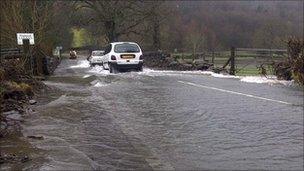Defences hold during heavy rain in Conwy Valley
- Published

Heavy rain caused flooding on some routes, such as Gwydr Road, Llanrwst
Flood defences in the Conwy Valley have protected 90 properties from flooding during two days of heavy rainfall.
An Environment Agency Wales spokesman said the scheme had "proven successful".
But the weekend was not completely problem-free, with one businesswoman saying the defences meant more water on roads leading to her village.
Meanwhile, work has ended on a pilot scheme assessing the risk to Pwllheli, Gwynedd, if sea levels rise by a metre.
An Environment Agency Wales spokesman said the Conwy Valley defence scheme had worked.
"Thanks to this defence scheme, we are very relieved to report that there has been no significant flooding in households in the communities of Llanrwst and Trefriw," said Alan Winstone.
"The schemes have proven successful during this very wet weekend, protecting 90 households from flooding."
Sea levels
Mr Winstone said that without the scheme "we would have very likely seen a significant number of households flooded in Llanrwst and Trefriw".
However, shopowner Eileen Galvin Jones said Trefriw was "completely isolated", and cars were lost in the rising waters.
"It has stopped the flooding, but once it rains now we are stuck in the village," said Ms Jones.
She said before the flood defences were put in place it was possible to access Trefriw from Betws-y-Coed, but that could not now be done.
"Now it's impossible to get here unless you know the back roads, it took one person I know two hours to get home," she said.
Ms Jones said the scheme had saved houses, but the river still needed dredging.
"The amount of rain on Saturday was nothing to what we had during the last two to three floods.
'Protecting 90 households'
"I don't think the bank will hold it (a very big flood), " she said.
In Pwllheli, a pilot scheme to assess the effects on the town if sea levels rise by one metre (about 3ft 3in) over the next century has just been completed.
The results of the pilot - which also involved Barry in the Vale of Glamorgan, and Prestatyn, Denbighshire - will be presented to the Welsh Assembly Government, which will then decide on the next steps.
Huw Williams, who co-ordinated the pilot at Pwllheli, said it had shown that despite the town having three rivers running through it, the greatest risk was from the sea.
"If we look at Pwllheli, and look where there are homes, the leisure centre, fire station, ambulance station and even the council offices, they are all on low-lying land," he said.
Mr Williams said there were large stones protecting the dunes, but the current defences would not be enough if sea levels rise one metre.
"If you think of a surge, on top of levels rising, it would go through these dunes," he added.
A number of public consultations were held as part of the pilot scheme and Pwllheli town councillor Michael Sol Owen said there had to be a balance between providing the town's residents with enough information, and causing panic.
"Fortunately we are one of the three pilot schemes and that is a great help to us," he said.
"The work that has been done has shown that unless something is done in Pwllheli then in 100 years there could be massive damage," he added.
- Published28 October 2010